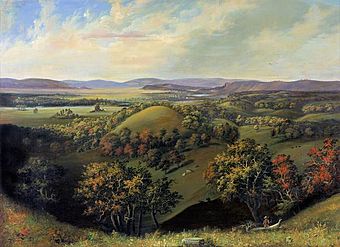Wisconsin Heights Battlefield facts for kids
Quick facts for kids |
|
|
Wisconsin Heights Battlefield
|
|

A 19th-century painting of the battlefield
|
|
| Location | Dane County, Wisconsin |
|---|---|
| Nearest city | Sauk City (in Sauk County) |
| Area | 70 acres (28 ha) |
| Built | 1832 (battle date) |
| NRHP reference No. | 01001553 |
| Added to NRHP | January 31, 2002 |
The Wisconsin Heights Battlefield is a special place in Dane County, Wisconsin. It was the site of an important battle during the 1832 Black Hawk War. This war was fought between the Illinois and Michigan Territory militias and the Sauk chief Black Hawk. His group was trying to escape their homeland.
This battlefield is unique. It is the only battle site from the Indian Wars in the U.S. Midwest that is still mostly untouched. Today, the state of Wisconsin protects and manages the battlefield. It is part of the Lower Wisconsin State Riverway. In 2002, it was added to the U.S. National Register of Historic Places. This means it is a very important historical site.
Contents
History of the Battlefield
Long ago, before the mid-1700s, different Native American tribes lived in this area. One group was called the "Fire Nation" or "Mascoutens." The Mascoutens, along with the Kickapoo and Miami tribes, likely lived near the Fox River. They used the land, including the battlefield area, for hunting. Later, these tribes moved further south.
After the Fox Wars, the Sauk and Fox tribes moved into this region. They sought safety in lands to the west. These lands stretched from the Wisconsin River north to the Illinois River south. Other settlements were made north of the Missouri River.
The Black Hawk War Battle
The Wisconsin Heights Battlefield was the site of a key battle in the 1832 Black Hawk War. This fight was between the United States state militia and the Sauk and Fox tribes. Black Hawk led the Native American warriors. The battle happened in what is now Dane County. It was near the border with Sauk County.
Black Hawk's warriors were outnumbered. Many of them were hurt or killed. But they fought bravely. They held off the militia long enough for most of the Sauk and Fox families to escape. These families crossed the Wisconsin River to safety.
Remembering the Battle
People have long found the battlefield area beautiful. For many years, it was privately owned land. On September 3, 1923, a special event took place. About 500 people gathered to dedicate a marker at the site. This marker was made of stone.
The Daughters of the American Revolution (DAR), the Wisconsin Historical Society, and the State Archaeological Society put up the marker. It had an important message:
WISCONSIN HEIGHTS BATTLEFIELD
Near this site the Sauk chieftain Black Hawk
and his band were overtaken by Wisconsin
and Illinois troops on July 21, 1832
For 30 years, this stone marker was the only monument. In 1957, the Wisconsin Historical Society added a metal sign. This sign helped explain the battle. In 1989, a law created the Lower Wisconsin State Riverway. This Riverway protects a long part of the Wisconsin River. It includes the Wisconsin Heights Battlefield. This protection stops new buildings from being built on the site.
Historians kept learning more about the battle. In 1992, a new sign was put up. In 1998, Wisconsin Governor Tommy Thompson dedicated the site. This was part of Wisconsin's 150th birthday celebration.
Exploring the Battlefield Today
During the Black Hawk War, the Wisconsin Heights Battlefield was a marshy area. It was located in the hills along the Wisconsin River. Today, the battlefield is part of the Black Hawk Unit. This unit is within the Lower Wisconsin State Riverway. You can find it along Highway 78. It is about a mile south of County Road Y, near Sauk City.
At the site, you can find trails, a historical marker, and a parking area. There are no modern restrooms or plumbing. The trails in the Black Hawk Unit are about three miles (5 km) long. They go over rough land. One trail, the Wisconsin Heights Battlefield Trail, leads right through the battle site.
Key Areas to See
The battlefield has three main areas you can visit. These spots were important during the battle:
- Militia Ridge: This is where the Illinois and Michigan Territory militia soldiers got ready for the fight.
- Sharpshooter Lookout: From here, Sauk and Fox warriors began firing at the militia. It offers a great view of the whole battlefield.
- Spy's Ravine: This is the area between Militia Ridge and Sharpshooter Lookout.
Why This Battlefield Is Important
The Wisconsin Heights Battlefield is very special. It is the only battle site from the Indian Wars in the U.S. Midwest that is still mostly untouched. Because of its importance, it was added to the U.S. National Register of Historic Places on January 31, 2002.
It is one of five Black Hawk War battle sites listed on the National Register. The others are Kellogg's Grove, Apple River Fort, Fort Blue Mounds, and Stillman's Run. The Wisconsin Heights site also has an official Wisconsin historical marker.
It is believed this is the exact spot of the battle. Old historical records describe this area. The land, with its ridges and marshy spots, matches those descriptions. Scientists have looked for clues at the site. They used metal detectors and ground-penetrating radar. They found some lead balls from the time of the Black Hawk War. They also found parts of old cartridge cases and a leather bag fastener. These small finds are important. At many other Black Hawk War battlefields, no archaeological evidence has been found at all.



